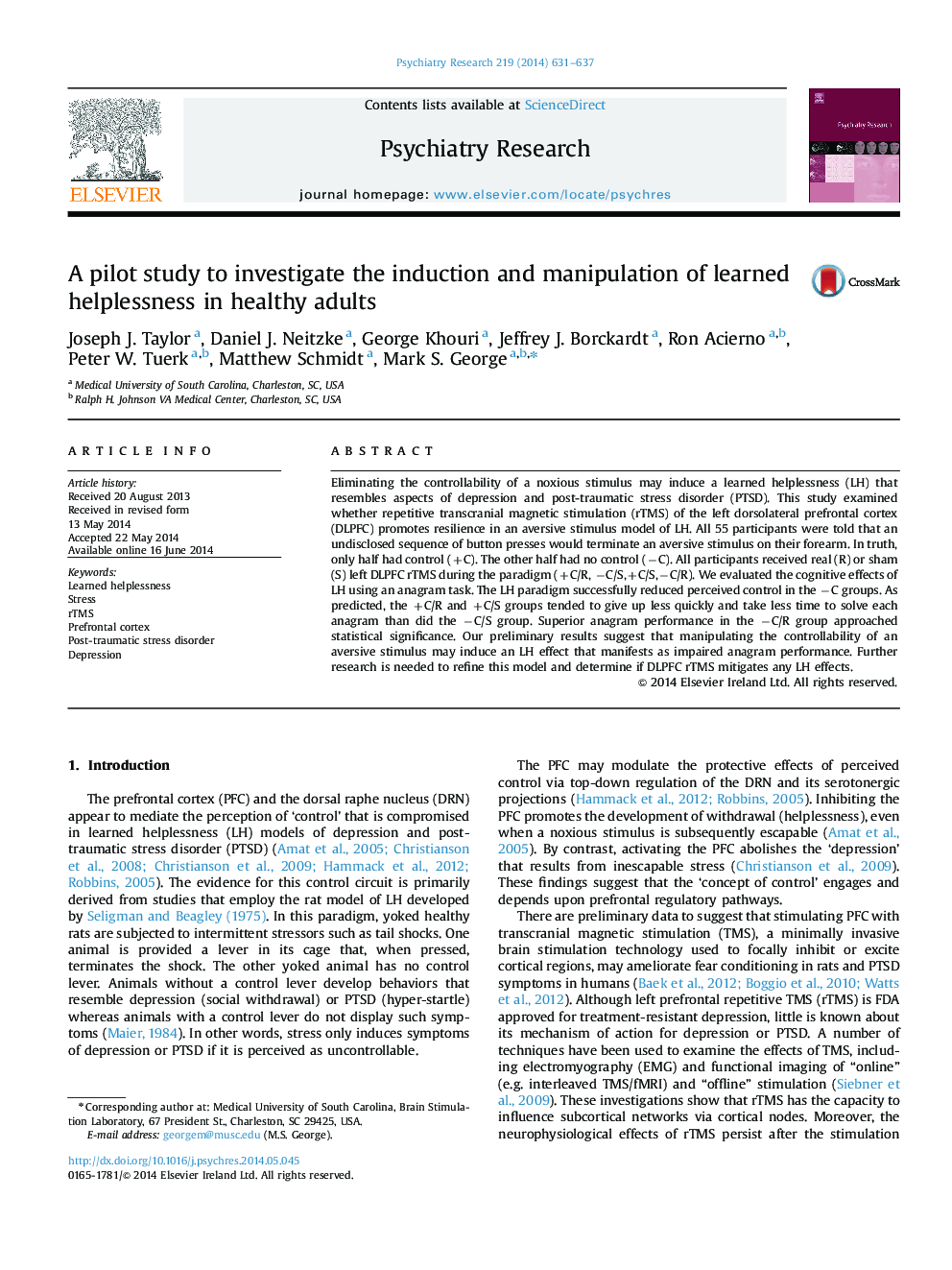| کد مقاله | کد نشریه | سال انتشار | مقاله انگلیسی | نسخه تمام متن |
|---|---|---|---|---|
| 332160 | 545669 | 2014 | 7 صفحه PDF | دانلود رایگان |
چکیده
1.مقدمه
2. مواد و روش ها
2.1. روش غربالگری
2.2. مروری برمطالعه
2.3. بررسی آستانه حرکتی و منطقه بندی جلوی مغز
2.4. تست محرک آزارنده مقدماتی
2.5. درمان rTMS واقعی یا ساختگی
2.6. الگوی محرک آزاردهنده
2.7. تمرین حروف درهم قابل حل
2.8. تجزیه و تحلیل داده ها و عدم اطلاع
شکل. 1. نمایش شماتیک روش مطالعه.
2.9. گزارش گیری از شرکت کنندگان
3. نتایج
3.1. جمعیت شناسی و اقدامات پایه
3.2. کنترل درک شده
3.3. عملکرد تمرین حروف درهم
3.3.1. سرعت حل حروف درهم
3.3.2. میزان شکست در حروف درهم
3.3.3. سرعت شکست در حروف درهم
4. بحث
4.1. بررسی فرضیه
جدول 1. مقایسه جمعیت شناسی و ویژگی ها از شروع مطالعه در چهار گروه مورد آزمایش.
شکل. 2. نمودار میزان ادراک کنترل را در هر یک از چهار گروه مورد آزمایش نشان می دهد.
شکل. 3. نمودار زمان متوسط برای رسیدن به یک راه حل درست را در هر یک از چهار گروه آزمایش شده نشان می دهد.
شکل. 4. نمودار میانگین تعداد پذیرش شکست را در هر یک از چهار گروه آزمایش شده نشان می دهد.
شکل. 5. نمودار متوسط زمان لازم برای پذیرفتن شکست (در ثانیه) در هر یک از چهار گروه مورد آزمایش نشان می دهد.
4.2. منطقی برای تحریک DLPFC جهت افزایش انعطاف پذیری
4.3. محدودیت ها و جهت گیری های آینده
5. نتیجه گیری
• Learned helplessness may resemble aspects of depression or PTSD.
• Uncontrollable noxious stimulation induces learned helplessness in healthy adults.
• The perception of control protects against feelings of learned helplessness.
• Individuals who felt helpless performed poorly on a subsequent anagram task.
• Prefrontal rTMS may protect against the cognitive effects of learned helplessness.
Eliminating the controllability of a noxious stimulus may induce a learned helplessness (LH) that resembles aspects of depression and post-traumatic stress disorder (PTSD). This study examined whether repetitive transcranial magnetic stimulation (rTMS) of the left dorsolateral prefrontal cortex (DLPFC) promotes resilience in an aversive stimulus model of LH. All 55 participants were told that an undisclosed sequence of button presses would terminate an aversive stimulus on their forearm. In truth, only half had control (+C). The other half had no control (−C). All participants received real (R) or sham (S) left DLPFC rTMS during the paradigm (+C/R, −C/S,+C/S,−C/R). We evaluated the cognitive effects of LH using an anagram task. The LH paradigm successfully reduced perceived control in the −C groups. As predicted, the +C/R and +C/S groups tended to give up less quickly and take less time to solve each anagram than did the −C/S group. Superior anagram performance in the −C/R group approached statistical significance. Our preliminary results suggest that manipulating the controllability of an aversive stimulus may induce an LH effect that manifests as impaired anagram performance. Further research is needed to refine this model and determine if DLPFC rTMS mitigates any LH effects.
Journal: Psychiatry Research - Volume 219, Issue 3, 30 November 2014, Pages 631–637
